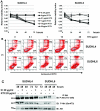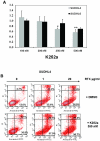Endogenous neurotrophins and Trk signaling in diffuse large B cell lymphoma cell lines are involved in sensitivity to rituximab-induced apoptosis
- PMID: 22076137
- PMCID: PMC3208602
- DOI: 10.1371/journal.pone.0027213
Endogenous neurotrophins and Trk signaling in diffuse large B cell lymphoma cell lines are involved in sensitivity to rituximab-induced apoptosis
Abstract
Background: Diffuse large B-cell lymphoma (DLBCL) is a common and often fatal malignancy. Immunochemotherapy, a combination of rituximab to standard chemotherapy, has resulted in improved survival. However a substantial proportion of patients still fail to reach sustained remission. We have previously demonstrated that autocrine brain-derived neurotrophic factor (BDNF) production plays a function in human B cell survival, at least partly via sortilin expression. As neurotrophin receptor (Trks) signaling involved activation of survival pathways that are inhibited by rituximab, we speculated that neurotrophins may provide additional support for tumour cell survival and therapeutic resistance in DLBCL.
Methodology/principal findings: In the present study, we used two DLBCL cell lines, SUDHL4 and SUDHL6, known to be respectively less and more sensitive to rituximab. We found by RT-PCR, western blotting, cytometry and confocal microscopy that both cell lines expressed, in normal culture conditions, BDNF and to a lesser extent NGF, as well as truncated TrkB and p75(NTR)/sortilin death neurotrophin receptors. Furthermore, BDNF secretion was detected in cell supernatants. NGF and BDNF production and Trk receptor expression, including TrkA, are regulated by apoptotic conditions (serum deprivation or rituximab exposure). Indeed, we show for the first time that rituximab exposure of DLBCL cell lines induces NGF secretion and that differences in rituximab sensitivity are associated with differential expression patterns of neurotrophins and their receptors (TrkA). Finally, these cells are sensitive to the Trk-inhibitor, K252a, as shown by the induction of apoptosis. Furthermore, K252a exhibits additive cytotoxic effects with rituximab.
Conclusions/significance: Collectively, these data strongly suggest that a neurotrophin axis, such NGF/TrkA pathway, may contribute to malignant cell survival and rituximab resistance in DLBCL.
Conflict of interest statement
Figures






References
-
- De Paepe P, De Wolf-Peeters C. Diffuse large B-cell lymphoma: a heterogeneous group of non-Hodgkin lymphomas comprising several distinct clinicopathological entities. Leukemia. 2007;21:37–43. - PubMed
-
- Coiffier B, Pfreundschuh M, Stahel R, Vose J, Zinzani PL. Aggressive lymphoma: improving treatment outcome with rituximab. Anticancer Drugs. 2002;13:43–50. - PubMed
-
- Coiffier B. Rituximab therapy in malignant lymphoma. Oncogene. 2007;26:3603–3613. - PubMed
-
- Uddin S, Hussain AR, Siraj AK, Manogaran PS, Al-Jomah NA, et al. Role of phosphatidylinositol 3′-kinase/AKT pathway in diffuse large B-cell lymphoma survival. Blood. 2006;108:4178–4186. - PubMed
Publication types
MeSH terms
Substances
LinkOut - more resources
Full Text Sources
Research Materials

